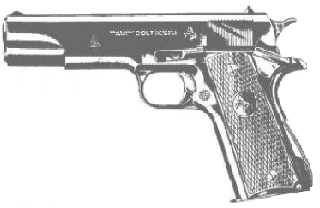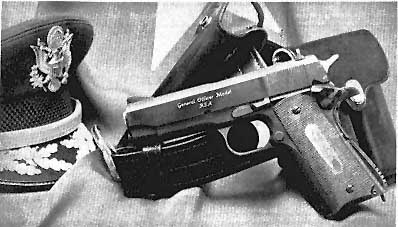

Each time a cartridge is fired, the parts of the pistol function in a given order. The cycle of functioning is divided into eight steps. It should be kept in mind that more than one step may occur at the same time. Assume for the purposes of this discussion that a loaded magazine is in the weapon and a live cartridge is in the chamber. The hammer is fully cocked, the safety lock is off, the grip safety is depressed, the trigger is squeezed and the round is ignited. The cycle of functioning begins.
1. Feeding
As the slide moves to the rear due to the force of recoil, the underside of it clears the top of the magazine. The magazine follower, under pressure from the magazine spring, forces the top round up against the lips of the magazine. This places the top round in position to be picked up by the face of the slide during its forward movement.
2. Chambering
At the termination of the rearward movement of the slide, the expanding recoil spring forces the slide forward. The lower portion of the face of the slide passes between the lips of the magazine, strips the top cartridge from the magazine and pushes it to the bullet ramp and up into the chamber. During this movement, the base of the cartridge slides up the face of the slide. At this time, the extractor enters the extracting groove in the head of the cartridge. Chambering is complete when the cartridge is fully seated in the chamber and the face of the slide is against the rear extension of the barrel.
3. Locking
After chambering is completed, the slide continues forward and pushes the barrel forward. As the slide continues to exert force against the rear of the barrel, the barrel pivots up and forward of the barrel link. At this time, the locking ribs on the barrel enter the locking recesses in the underside of the slide. The forward movement of the recoiling parts terminates when the barrel lugs strikes the slide stop pin.
4. Firing
When the grip safety is depressed and the trigger is squeezed, the trigger bar presses against the disconnector which in turn transmits this movement to the sear. The sear rotates on the sear pin and disengages from the full cock notch of the hammer. The expanding mainspring pushes the hammer strut up, rotating the hammer to rotate forward on the hammer pin and strike the firing pin. The inertia firing pin travels forward, compressing the firing pin spring.The firing pin moves through the firing pin well in the face of the slide and strikes the cartridge's primer. The primer ignites the propellant and the expanding gases force the bullet through the barrel. The firing pin spring expands and withdraws the firing pin from the face of the slide.
5. Unlocking
As the gases expand, equal pressure is exerted in all directions. These gases force the bullet down the barrel and force the slide to the rear. As the slide moves to the rear, it carries the barrel with it. The barrel link pivots about the slide stop pin, which is attached to the stationary receiver, and draws the barrel downward as well as to the rear. As the barrel is pivoted downward, the barrel locking ribs are disengaged from the locking recesses in the slide and unlocking is completed.
6. Extracting
The slide continues its rearward movement and the extractor, engaged in the extracting groove of the cartridge, withdraws the cartridge case from the chamber. Extracting is completed as the cartridge clears the chamber.
7. Ejecting
As the slide continues to move to the rear, the cartridge case, which is held against the face of the slide by the extractor, strikes the ejector on the receiver, pivots on the extractor and is ejected from the pistol through the ejection port.
8. Cocking
Cocking begins as the slide starts rearward in recoil. The firing pin stop pushes the hammer rearward and the hammer strut is pushed down against the mainspring cap, compressing the mainspring. Rearward movement of the slide terminates as the lower projection of the slide strikes the recoil spring guide. The expanding recoil spring causes the slide to begin its forward movement. As the slide moves forward, the hammer follows the slide for a short distance; then the sear, which is bearing against the hammer through the action of the sear spring, enters the full cock notch of the hammer and holds it in the cocked position. When the slide is fully forward and the trigger is released, the disconnector positions in its recesses in the bottom of the slide and cocking is completed.
Source for the above information: Guidebook for Marines - 14th edition

![]() © Copyright Michael KAY 1997.
© Copyright Michael KAY 1997.
![]() Colt Firearms Share Certificate
Colt Firearms Share Certificate
![]() Download My Submission on "Gun Laws" Zipped WordPerferct 6.1 Windows Format 740k
Download My Submission on "Gun Laws" Zipped WordPerferct 6.1 Windows Format 740k
![]()
![]()